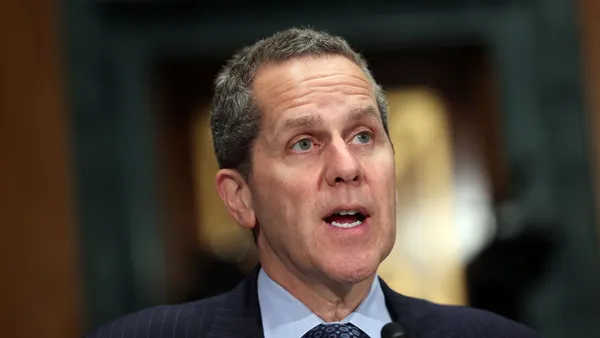UPDATE: March 8, 2021: The Office of Federal Contract Compliance Programs (OFCCP) closed its inquiry into Wells Fargo's diversity hiring goals in October, The Wall Street Journal reported Saturday, citing a Labor Department spokesman. The agency ended its inquiry into a similar initiative by Microsoft in December, the spokesman said.
"Microsoft and Wells Fargo responded to the inquiries with in-depth descriptions, materials, and data," he said. "OFCCP was satisfied with the response, and the inquiries are closed."
Dive Brief:
- Wells Fargo received a letter last week from the Office of Federal Contract Compliance Programs (OFCCP), a Labor Department arm, reminding the bank that federal law prohibits race-based quotas and hiring based on race, The Wall Street Journal and Bloomberg reported Tuesday.
- The bank in June pledged to double Black leadership by 2025 — senior management at Wells Fargo is 6% Black — but the language CEO Charlie Scharf used to launch the effort has since drawn fire. "While it might sound like an excuse, the unfortunate reality is that there is a very limited pool of Black talent to recruit from with this specific experience as our industry does not have enough diversity in most senior roles," Scharf said in a June memo.
- News of the OFCCP correspondence came to light when a Microsoft executive posted a blog Tuesday defending her company's similar pledge to double Black leadership in the same time frame.
Dive Insight:
Wells Fargo is far from alone — even in the financial sector — in laying out desired diversity goals, although it was among the first to do so after the May killing of George Floyd put a renewed focus on racial inequality.
The San Francisco-based lender in June said its operating committee members' efforts to increase representation and inclusion of diverse employees at the bank would be reflected in their year-end pay packages. It has also added two Black executives to that committee in the past year.
In the seven weeks that followed, Goldman Sachs, HSBC, Mastercard and Visa all forged their own diversity blueprints — with Goldman's most clearly defining its targets with percentages. The bank wants 7% of its vice presidents to be Black, 9% to be Latino and 40% to be women by 2025, CEO David Solomon wrote in an August statement posted on the bank's website and emailed to staff.
And the bank's use of specific percentages is not new. Goldman said last year it wanted 11% of its newly hired U.S.-based analysts and entry-level associates to be Black, 14% to be Latino and half to be women.
"Setting goals is encouraged," Camille Olson, a Chicago-based partner with Seyfarth Shaw told The Wall Street Journal, adding that such targets align with the OFCCP's mission as a watchdog for contractors' affirmative-action obligations. "This is something companies have done for years and years."
The agency's shift in tone may reflect the Trump administration's Sept. 22 executive order barring federal contractors from conducting "divisive" training. Six days later, the OFCCP announced it had established a hotline and email address so employees could submit complaints regarding "offensive and anti-American race and sex stereotyping and scapegoating" for the agency to investigate.
The OFCCP's letters to Wells Fargo and Microsoft were dated the following day, Sept. 29, according to the Journal.
Dev Stahlkopf, Microsoft's corporate vice president and general counsel, in her blog post Tuesday, said the OFCCP, in its letter, asked the tech giant to prove its effort to double the number of Black managers and leaders in its U.S. workforce by 2025 won't result in race-based hiring decisions that would violate Title VII of the Civil Rights Act.
"We are clear that the law prohibits us from discriminating on the basis of race," Stahlkopf wrote in her post. "We also have affirmative obligations as a company that serves the federal government to continue to increase the diversity of our workforce, and we take those obligations very seriously."
About 4.5% of Microsoft's U.S.-based employees and less than 3% of senior leaders are Black, the company shared in its 2019 diversity report.
But the OFCCP, Stahlkopf wrote, suggested the company's June announcement of intent to boost those numbers "appears to imply that employment action may be taken on the basis of race."
"We hire and promote the most qualified person. And nothing we announced in June changes that," Stahlkopf wrote. "We have every confidence that Microsoft's diversity initiative complies fully with all U.S. employment laws. We look forward to providing the OFCCP with this information and, if necessary, defending our approach."
Wells Fargo, for its part, "is committed to and taking action to become a more diverse and inclusive company," a spokesperson for the bank said in a statement to Bloomberg and the Journal. "Numerous efforts are under way to implement changes at all levels of the company, and we are confident that they comply with U.S. employment laws."
A Labor Department spokeswoman told the Journal the agency "appreciates Microsoft's assurance on its website that it is not engaging in racial preferences or quotas in seeking to reach its affirmative-action and outreach goals. OFCCP looks forward to working with Microsoft to complete its inquiry."
The agency didn't respond to questions about the Wells Fargo letter or how many companies received similar notices.
The OFCCP's shift in tone "seems like a perversion of everything this agency is supposed to be about," Samuel Bagenstos, a law professor at the University of Michigan, told Bloomberg. Microsoft's effort to address shortcomings in diversity "is the kind of thing that, in prior administrations, the Department of Labor had been telling federal contractors they should be doing," he said.
"Although contractors must establish affirmative-action programs to set workforce utilization goals for minorities and women based on availability, contractors must not engage in discriminatory practices in meeting these goals," OFCCP Director Craig Leen wrote, according to the Journal.
In other words, spelling out hiring goals is legal, labor law experts said, but enforcing racial or diversity quotas in hiring is not.
"Goals are flexible," Jenny Yang, a former chair of the Equal Employment Opportunity Commission under President Barack Obama, told the Journal. "I worry the OFCCP is confusing matters by suggesting that simply having a goal as a federal contractor is somehow going to land you in hot water."
Wells Fargo has run afoul of the OFCCP before. The bank in August agreed to make job offers to 580 applicants and pay $7.8 million in back wages and interest to settle the agency's allegations of hiring discrimination against Black people and women. However, the agreement pertained to a review of hiring data from six to 10 years ago, Peter Gilchrist, a Wells Fargo spokesman, told Banking Dive's sister publication, HR Dive.
Wells Fargo and Microsoft "are on sound legal footing if they take steps to address a documented shortfall," Cyrus Mehri, a founding partner of Mehri & Skalet, told the Journal.














